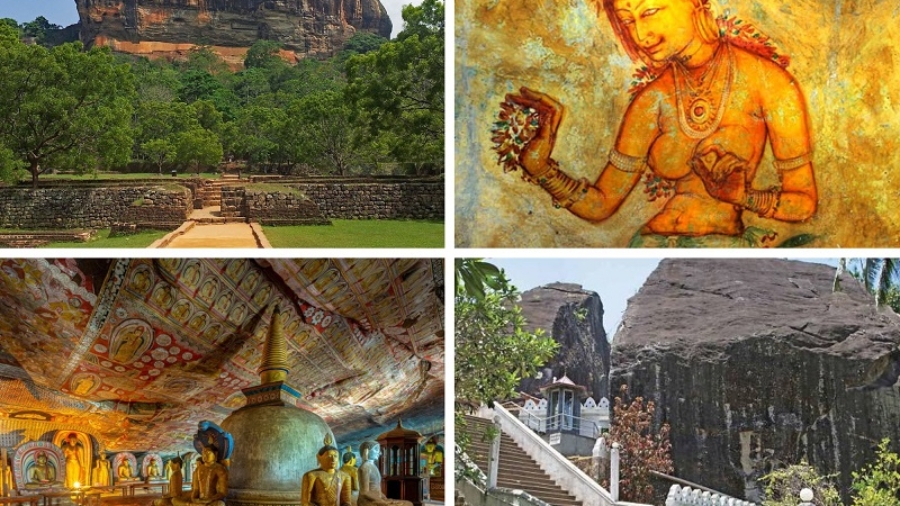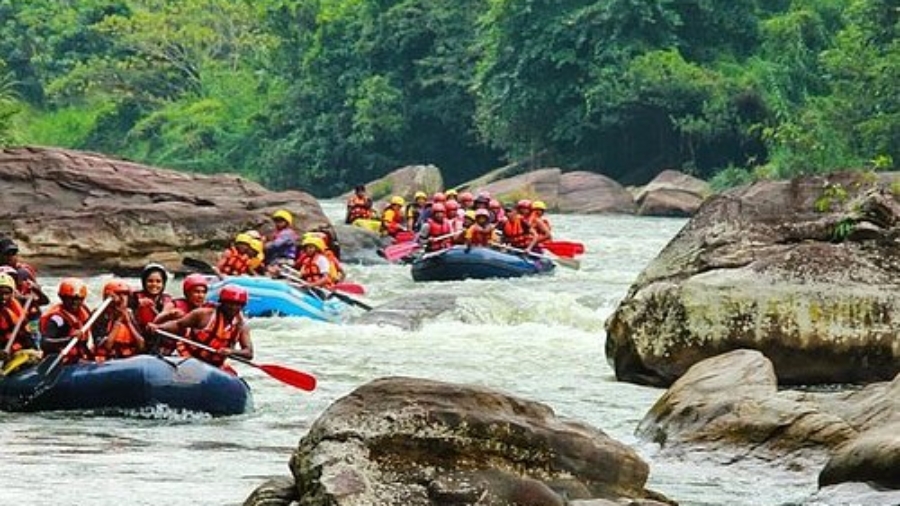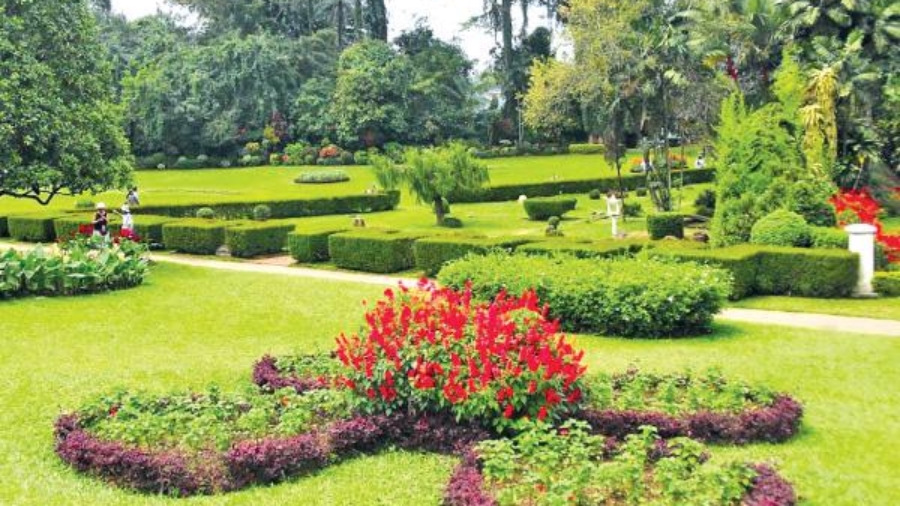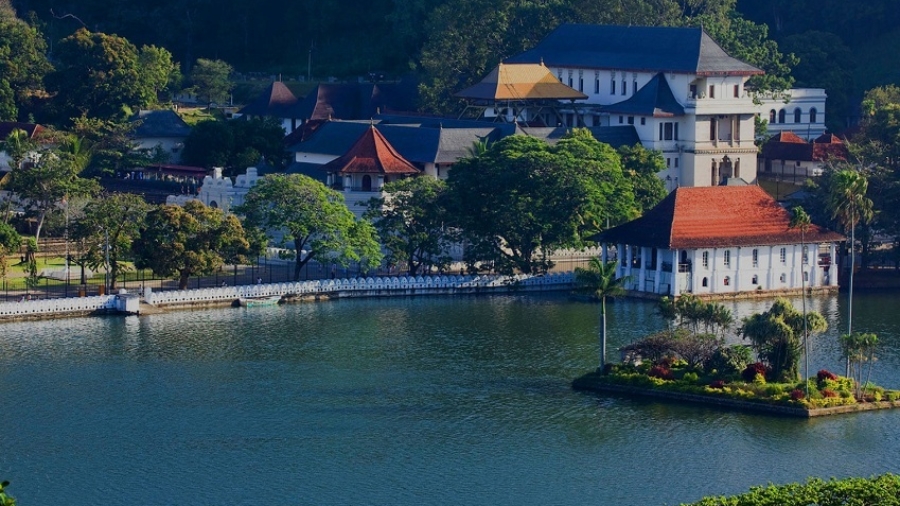Colombo, the capital city of Sri Lanka, is a vibrant and diverse metropolis that offers a unique blend of natural beauty and spiritual experiences.Despite being a bustling urban center, Colombo boasts several natural attractions that allow residents and visitors to connect with nature.
Table of Contents
- Gangaramaya Temple
- Kelaniya Raja Maha Viharaya
- Attidiya Bird Sanctuary
- Beddagana Wetland Park
- Seethawaka Botanical Garden
- Beira Lake
- Viharamahadevi Park
- Galle Face Green
- Mount Lavinia Beach
- National Zoological Gardens of Sri Lanka(Dehiwala Zoo)
Gangaramaya Temple
Gangaramaya Temple is one of the most prominent Buddhist temples in Colombo, Sri Lanka. It holds great religious and cultural significance and attracts both locals and tourists.
Location: Gangaramaya Temple is located in the heart of Colombo, near the scenic Beira Lake. Its address is 61 Sri Jinarathana Road, Colombo 2.
The temple was founded in the late 19th century by Venerable Hikkaduwe Sri Sumangala Nayaka Thera. Over the years, it has been expanded and renovated to its present grandeur.
Gangaramaya Temple showcases a blend of architectural styles, incorporating elements of Sri Lankan, Thai, Indian, and Chinese architecture. The complex features a mix of traditional and modern structures.
The temple complex is vast and includes several buildings, halls, and shrines. It comprises a main temple building, a museum, an assembly hall, a library, residential quarters for monks, and a bo tree (sacred fig tree).
Sacred Relics: Gangaramaya Temple houses various sacred relics, including relics of Lord Buddha and artifacts associated with other Buddhist traditions. These relics are revered by devotees who visit the temple.
Seema Malakaya is situated in Beira Lake, adjacent to the main temple complex, Seema Malaka is a floating meditation hall and shrine. This serene wooden structure provides a tranquil space for meditation and worship.
Cultural Events: Gangaramaya Temple is renowned for its grand celebrations of Vesak, the most significant Buddhist festival in Sri Lanka. During this time, the temple and its surroundings are adorned with elaborate decorations and vibrant illuminations.
The Nawam Perahera is held to commemorate the historic meeting between Lord Buddha and the deities of Sri Lanka, which is believed to have taken place on the full moon day of the month of Nawam(February). The Perahera attracts a large number of participants and spectators from different parts of the country and abroad. The highlight of the Perahera is the grand procession, where elaborately decorated elephants, traditional dancers, drummers, and flag bearers parade through the streets around Gangaramaya Temple. The procession showcases the rich cultural heritage of Sri Lanka and attracts a large number of spectators.
Kelaniya Raja Maha Viharaya
Kelaniya Raja Maha Viharaya is a prominent Buddhist temple located in Kelaniya, a suburb of Colombo, Sri Lanka.
Historical Significance: Kelaniya Raja Maha Viharaya has a rich history that dates back over 2,500 years. According to legends, it is believed that Lord Buddha visited the site during his third visit to Sri Lanka. The temple is mentioned in several ancient texts, including the Mahavamsa, an important historical chronicle of Sri Lanka.
Sacred Stupa: The main attraction of Kelaniya Temple is its large stupa (dome-shaped structure), which is believed to enshrine a sacred hair relic of Lord Buddha. The stupa is beautifully decorated and attracts devotees who offer flowers, light lamps, and engage in religious rituals.
Murals and Paintings: The walls of the temple are adorned with intricate murals and paintings depicting scenes from Buddhist mythology and the life of Lord Buddha. These vibrant and detailed artworks are considered important examples of traditional Sri Lankan Buddhist art.
Sacred Bo Tree: Within the temple premises, there is a sacred Bodhi tree, which is a descendant of the original Bodhi tree in Bodhgaya, India, under which Gautama Buddha attained enlightenment. The Bodhi tree is revered by devotees and serves as a place for meditation and offering prayers.
Annual Duruthu Perahera: Kelaniya Temple is famous for hosting the annual Duruthu Perahera, a grand procession held in January to commemorate Lord Buddha’s first visit to Sri Lanka. The Perahera features beautifully decorated elephants, traditional dancers, drummers, and devotees parading through the streets surrounding the temple.
Kelaniya Raja Maha Viharaya is a popular destination for Buddhist pilgrims, both local and foreign. Many devotees visit the temple to pay homage to Lord Buddha, seek blessings, and engage in religious activities such as offering alms to monks and participating in religious ceremonies.
Attidiya Bird Sanctuary
Attidiya Bird Sanctuary, also known as the Attidiya Wetland Park, is a significant bird sanctuary located in the outskirts of Colombo.
Location: Attidiya Bird Sanctuary is situated in Attidiya, a suburb located approximately 15 kilometers south of Colombo’s city center. It covers an area of around 300 hectares.
Wetland Habitat: The sanctuary comprises a diverse wetland ecosystem, including marshes, lagoons, lakes, and mangrove forests. These habitats attract a wide variety of bird species and other wildlife.
Bird Species: Attidiya Bird Sanctuary is home to over 160 bird species, including both resident and migratory birds. Some of the notable bird species found in the sanctuary include herons, egrets, kingfishers, terns, jacanas, and various waterfowl.
The sanctuary offers excellent bird watching opportunities, attracting both bird enthusiasts and nature lovers. Visitors can observe and photograph the diverse bird species in their natural habitat.
Biodiversity: The sanctuary supports a rich diversity of wildlife, including reptiles, amphibians, butterflies, and small mammals. Visitors may encounter species such as monitor lizards, water monitors, and various fish species.
The Attidiya Bird Sanctuary plays a vital role in conserving the wetland ecosystem and its associated biodiversity. Efforts are made to protect and preserve the sanctuary’s natural environment, including initiatives for habitat restoration and sustainable management.
Nature Trails: Attidiya Bird Sanctuary features designated walking trails that allow visitors to explore the wetland environment. These trails provide an opportunity to appreciate the flora and fauna while enjoying a peaceful nature walk.
Beddagana Wetland Park
The is an important ecological site that aims to preserve and protect the wetland ecosystem. It serves as a habitat for various bird species, aquatic plants, and other wildlife, contributing to the overall biodiversity of the area.
Scenic Setting: The park offers a scenic and tranquil environment, providing a refreshing escape from the urban hustle and bustle of Colombo. The wetland area is characterized by marshes, ponds, and water bodies, surrounded by lush greenery and tall grasses.
Bird Watching: Beddagana Wetland Park is a haven for bird enthusiasts. The wetland attracts a wide variety of bird species, including resident birds and migratory birds. Visitors can observe and appreciate the diverse avian population in their natural habitat.
Nature Trails: The park features well-maintained walking trails that meander through the wetland area and surrounding landscapes. These trails allow visitors to explore the park’s natural beauty, observe wildlife, and enjoy leisurely walks amidst nature.
Biodiversity Conservation: The wetland ecosystem of Beddagana Wetland Park supports a rich variety of flora and fauna. The park’s conservation efforts contribute to the protection of native plant species and the preservation of habitat for many animals, including reptiles, amphibians, and small mammals.
Recreational Activities: The park provides recreational facilities for visitors to engage in outdoor activities. These include picnic areas, jogging tracks, and children’s play areas, making it a popular destination for families, nature lovers, and fitness enthusiasts.
The Beddagana Wetland Park provides a peaceful and immersive nature experience within the city of Colombo. With its focus on wetland conservation, bird watching opportunities, and recreational facilities, it offers a unique blend of environmental conservation, education, and outdoor leisure for visitors to enjoy.
Seethawaka Botanical Garden
The Seethawaka Botanical Garden, also known as the Seethawaka Wet Zone Botanic Garden, offers a serene and picturesque environment that showcases the natural beauty of Sri Lanka’s wet zone flora. With its location just 49.2 km away from Colombo, it’s easily accessible for visitors.
Diverse Plant Life: The garden is home to a wide variety of plant species, including both endemic and endangered plants. You can find lush foliage, vibrant flowers, and unique vegetation representative of the wet zone ecosystem in Sri Lanka. Seethawaka Botanic Garden, serves as a research area and focuses on the conservation of vulnerable and threatened endemic plant species found in the Sinharaja Forest Reserve region.
Scenic Stream: A beautiful stream flows through the garden, adding a tranquil and refreshing element to the surroundings. The stream enhances the natural appeal of the garden and supports the growth of wet zone plants.
Landscaped Gardens: The botanical garden features well-maintained and carefully designed landscaped areas, showcasing different types of plants and creating visually appealing displays. These areas provide excellent opportunities for leisurely walks and exploration.
Canopy Walkway: The Seethawaka Botanical Garden offers a unique experience with its canopy walkway. Elevated pathways allow visitors to stroll through the upper levels of the forest, providing breathtaking views of the garden’s greenery and the surrounding landscape.
Biodiversity and Wildlife: The garden’s dedication to conserving endemic and threatened plant species attracts a diverse array of wildlife. Birds, butterflies, and other small creatures can often be spotted amidst the foliage, enhancing the overall beauty and ecological significance of the garden.
Natural Surroundings: The botanical garden is located in close proximity to the Indikada Mukalana Forest Reserve, further enhancing its natural surroundings. The lush greenery and the harmonious coexistence of the garden with the neighboring forest contribute to the overall beauty and tranquility of the area.
Visiting the Seethawaka Botanical Garden allows you to immerse yourself in the captivating beauty of Sri Lanka’s wet zone flora, explore its diverse plant life, and appreciate the natural splendor of the surroundings.
Beira Lake
Location: Beira Lake is situated in the Colombo 2 district, bordered by several significant landmarks such as Gangaramaya Temple and the Colombo Fort area.
Historical Significance: The lake has a rich history dating back to the colonial era. It was initially constructed by the Portuguese in the 16th century and expanded during the Dutch and British colonial periods. It served as a defensive moat and played a vital role in the city’s development.
Scenic Beauty: Beira Lake is known for its picturesque setting, with serene waters surrounded by lush greenery. It offers a tranquil escape from the bustling city and provides a soothing ambiance for visitors.
Boat Rides: Visitors can enjoy boat rides on Beira Lake, providing a unique perspective of the surroundings. Pedal boats and motorized boats are available for hire, allowing you to explore the lake and its surroundings at a leisurely pace.
Beira Lake’s combination of natural beauty, cultural significance, and recreational opportunities make it a popular attraction in Colombo. Whether you’re taking a boat ride, visiting Seema Malaka, or simply enjoying the peaceful ambiance, Beira Lake offers a delightful experience for locals and tourists alike.
Mount Lavinia Beach provides a blend of natural beauty, recreational opportunities, and dining experiences. Whether you want to soak up the sun, indulge in seafood delights, enjoy water activities, or simply relax by the ocean, the beach offers a delightful escape from the city buzz of Colombo.
Viharamahadevi Park
Location: Viharamahadevi Park is situated near the Town Hall complex, on the edge of Colombo’s bustling city center. It covers an area of approximately 10 hectares.
History: The park was originally named Victoria Park in honor of Queen Victoria of the United Kingdom during the colonial era. After Sri Lanka gained independence, it was renamed Viharamahadevi Park, in tribute to Queen Viharamahadevi, a legendary queen in Sri Lankan history.
Children’s Play Area: The park features a dedicated children’s play area with various recreational facilities, including swings, slides, and climbing structures. It is a popular spot for families and children to enjoy outdoor activities.
Walking and Jogging Paths: Viharamahadevi Park provides paved paths that are ideal for leisurely walks, jogging, or cycling. These paths wind through the park, offering visitors a chance to enjoy nature and exercise in a peaceful environment.
Landscaping and Features: Viharamahadevi Park is beautifully landscaped with lush greenery, flowering trees, and well-maintained lawns. It offers a serene and refreshing environment amidst the urban setting.
Viharamahadevi Park offers a peaceful retreat in the heart of Colombo, providing opportunities for relaxation, recreation, and appreciation of nature. Whether you want to take a leisurely stroll, enjoy a picnic, or let children play, the park is a popular destination for both locals and tourists.
Galle Face Green
Location: Galle Face Green stretches along the coast of the Indian Ocean, adjacent to the Galle Road, in the Colombo 3 and Colombo 4 areas.
Historical Significance: Galle Face Green has a rich history dating back to the colonial era. It was initially cleared by the Dutch in the 17th century and later expanded by the British. Originally used for military purposes, it evolved into a recreational space over time.
Galle Face Green is a vast open space that features a wide expanse of well-maintained grassy areas. The park offers a perfect spot for picnics, family gatherings, kite flying, and other outdoor activities. It is also an ideal place to relax and enjoy the ocean breeze.
One of the main attractions of Galle Face Green is the stunning view of the Indian Ocean. Visitors can walk along the promenade, which runs parallel to the coastline, and enjoy panoramic views of the sea. It’s a popular spot for sunset watching.
Galle Face Hotel: Adjacent to Galle Face Green is the iconic Galle Face Hotel, one of Sri Lanka’s oldest and most prestigious hotels. The hotel’s colonial architecture and historical significance add to the charm of the area.
Galle Face Green offers a vibrant and lively atmosphere, combining recreational activities, stunning views, delicious street food, and a touch of history. It is a beloved gathering place for locals and tourists alike, providing a refreshing escape from the city and an opportunity to experience the coastal beauty of Colombo.
Mount Lavinia Beach
Mount Lavinia Beach is situated approximately 12 kilometers south of Colombo’s city center, making it easily accessible for both locals and tourists.
Scenic Beauty: The beach offers a picturesque setting with golden sands, palm trees, and the sparkling waters of the Indian Ocean. It provides a serene and relaxing environment for visitors to unwind and enjoy the coastal scenery.
Watersports: Visitors can engage in various watersports activities at Mount Lavinia Beach, such as jet skiing, banana boat rides, and windsurfing. Rental services are available for those interested in exploring the ocean in a more adventurous way.
Mount Lavinia Beach is renowned for its stunning sunsets. The evenings offer a breathtaking view as the sun dips below the horizon, casting a golden glow over the ocean. It’s a perfect time to capture memorable photographs or enjoy a romantic stroll along the shore.
Mount Lavinia Hotel: Overlooking the beach is the historic Mount Lavinia Hotel, a colonial-era hotel with a fascinating history. It adds to the charm of the area and offers upscale accommodation, dining, and entertainment options.
Mount Lavinia Beach provides a blend of natural beauty, recreational opportunities, and dining experiences. Whether you want to soak up the sun, indulge in seafood delights, enjoy water activities, or simply relax by the ocean, the beach offers a delightful escape from the city buzz of Colombo.
National Zoological Gardens of Sri Lanka(Dehiwala Zoo)
The National Zoological Gardens of Sri Lanka, commonly known as the Dehiwala Zoo, is a popular tourist attraction located in Dehiwala, a suburb of Colombo, Sri Lanka.
History: The Dehiwala Zoo was established in 1936 and is one of the oldest zoological gardens in Asia. It spans across an extensive area of around 30 hectares and is home to a diverse range of animal species.
Animal Collection: The zoo houses over 3,000 animals representing more than 350 species, including mammals, birds, reptiles, and fish. Visitors can see animals such as elephants, lions, tigers, bears, primates, crocodiles, snakes, and a variety of bird species.
Conservation Efforts: The Dehiwala Zoo actively participates in conservation and breeding programs to protect and preserve endangered species. It collaborates with local and international organizations to support breeding, research, and educational initiatives.
Highlights and Exhibits: The zoo offers various exhibits and attractions to engage visitors. Some notable highlights include:
Elephant Show: Witness trained elephants showcasing their intelligence and skills in a dedicated show.
Butterfly Garden: Explore a serene garden filled with colorful butterflies fluttering around.
Aquarium: Discover a diverse array of marine life, including fish, turtles, and other aquatic species.
Reptile House: View a collection of reptiles, including venomous snakes, lizards, and crocodiles.
Walk-through Aviary: Walk through a large aviary where you can observe and interact with a variety of bird species.
Primate Complex: Observe different primate species, including monkeys and lemurs, in their naturalistic enclosures.
Conservation-friendly Practices: The Dehiwala Zoo aims to promote conservation-friendly practices within its premises. Efforts are made to ensure animal welfare, environmental sustainability, and responsible visitor engagement.
The Dehiwala Zoo provides an opportunity to observe and learn about a diverse range of animal species, making it a popular destination for families, wildlife enthusiasts, and tourists visiting Colombo.



